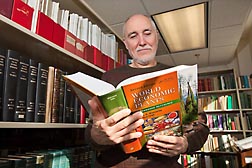Washington, DC, USA
March 17, 2014

At the ARS Germplasm Resources Information Network (GRIN) taxonomy botany library in Beltsville, Maryland, botanist John Wiersema reviews the new edition of “World Economic Plants: A Standard Reference,” which he coauthored. Photo by Stephen Ausmus.
At the ARS Germplasm Resources Information Network (GRIN) taxonomy botany library in Beltsville, Maryland, botanist John Wiersema reviews the new edition of “World Economic Plants: A Standard Reference,” which he coauthored.A new reference book written by a U.S. Department of Agriculture (USDA) scientist and his university colleague should prove to be an invaluable resource for researchers, plant breeders, librarians or anyone who wants basic, accurate information about important plants.
Photo by Stephen Ausmus.
World Economic Plants: A Standard Reference took more than two years to complete and was reviewed by more than 150 experts. At 1,336 pages, it is more for professionals and scientists than for casual readers. It was written by John Wiersema, a botanist with USDA's Agricultural Research Service (ARS), and Blanca León, a University of Texas taxonomist.
The authors link the list of scientific names of 12,235 plants with their geographic origins and uses. They also provide more than 50,000 common names for those plants in 27 languages, including Arabic, Chinese and Russian. Plants often have different names and uses in different countries.
The book is an update of an edition published ikn 1999 that inventoried 9,500 plants, according to Wiersema, who works in ARS' National Germplasm Resources Laboratory in Beltsville, Md. ARS is USDA's principal intramural scientific research agency, and this research supports the USDA priority of promoting international food security.
The updated version was requested by the publisher CRC Press. Along with including 25 percent more plants, the new version indicates more "use classes," such as whether a plant is a food source or has been used medicinally. Some of the most common use categories are ornamentals (5,361), medicines (2,997), food and food additives (2,212), and weeds (2,136).
Information in the book and its sources can also be found in the ARS Germplasm Resources Information Network (GRIN), which is part of the ARS National Plant Germplasm System and is publicly available online.
The book can be ordered online at: http://www.crcpress.com/product/isbn/9781439821428.
Read more about this research in the March 2014 issue of Agricultural Research magazine.